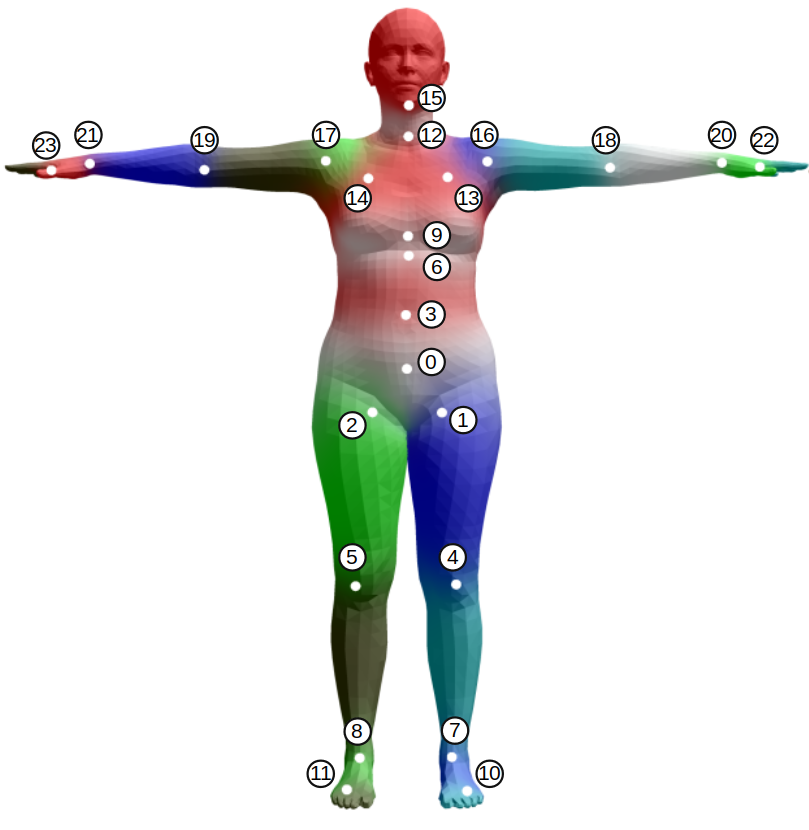SMPL++
A C++ Implementation of SMPL - A Skinned Multi-Person Linear Model.
Overview
This project implements a 3D human skinning model - SMPL: A Skinned Multi-Person Linear Model with C++. The official SMPL model is available at http://smpl.is.tue.mpg.de.
The author-provided implementation based on chumpy and opendr contains
spaghetti code,
and it cannot run on GPUs yet. I convert and modify another Tensorflow
version of SMPL contributed by CalciferZh to
C++ style.
You can find the Tensorflow implementation
here.
However, Tensorflow C++ APIs are not user-friendly, so I choose the Pytorch
C++ APIs - libTorch - instead.
For more details, see the paper published by Max Planck Institute for Intelligent Systems on SIGGRAPH ASIA 2015.
Prerequisites
The code in this project have been tested on my machine. I'm not sure how the performance will be on other system environments.
-
GPU
NVIDIA GeForce GTX 960M
-
OS
Ubuntu 18.04 LTS
-
Packages
-
xtensor: A C++ library meant for numerical analysis with multi-dimensional array expressions.
This library are inspired by
numpysuch that you can even find functions with same names in it. There is also a cheat sheet fromnumpytoxtensorin its documentation.Currently, I only use
xtensoras a IO interface to define random inputs for module test and restore hyperparameters from JSON format. The data in the buffer of axtensorarray can be fed into a corresponding "torch tensor" later. -
nlohmann_json: JSON for Modern C++.
xtensorloads and dumps data to json, using the json library written by nlohmann. -
libTorch: Pytorch C++ API.
PyTorch C++ API simplifies tensor computing and introduces GPU acceleration to this work, using
CUDAandcuDNN.Note: I installed nightly version of
libTorchwithCUDA 10.0support. -
CUDA: NVIDIA parallel computing platform.
Version 10.0 has been tested on my machine, but I think the corresponding versions within the
libTorchdownload list are all available. -
CMake: A tool to build, test and package C++ softwares.
The
CMakeinstalled byapt-getisCMake 3.5.1which causes a failure whenlibTorchtries to findCUDA. Here is a description about the problem.You should update it to a newer version, say 3.13.4 (>=3.12.2 should work). Delete the old
CMake, download a newer source code on official website and build it from scratch.
Usage
-
Package Installation
I only want to talk about tricks to install packages into root directory correctly. If you want to link packages manually, just skip this part and install in the normal ways.
To install packages successfully, follow the instructions in their official documentations or just search on google.
-
Source Code
Compile libraries and headers into root directory, e.g.
xtensor:
-
change to
xtensorrepo that you have cloned from github.cd <xtensor-dir> -
create a directory to compile the package and change to it.
mkdir build cd build -
configure
CMakeand generate makefiles. Remember to attach the installation directory to the root.cmake -D CMAKE_INSTALL_PREFIX=/usr/local ..You can change "/usr/local" to other root location as long as
CMakeis able to find the package automatically. -
compile and install.
make sudo make install
-
Binary Library
Move pre-built packages into root directory, e.g.
libTorch:
-
change to
libTorchdirectory.cd <libTorch-dir> -
copy
CMakeconfigurations to "lib" directory.cp -rv share/cmake lib -
copy headers and libraries to root directory.
cp -rv include lib /usr/localAfterwards, you don't need to specify path to the
libTorchlibrary when buildinglibTorch-dependent projects withCMake. This trick is a little bit different from the guide in officiallibTorchdocumentation.
-
-
Build and Run
After installing all packages, you can compile SMPL++ from source:
mkdir build cd build cmake .. makeThese command will produce a executable program named "smplpp". To run it, just type
./smplppin the terminal.
To track the usage of GPU, use following command:
nvidia-smi -lms
Instructions
Now, here is only a raw framework for SMPL++. I have written a lot of comments in the source code, you can just check them directly.
-
Forward Propagation
SMPL++ implement the model described in the paper. The inputs of the system are shape coefficients
$\beta$ , pose axis-angle parameterization$\theta$ and body translation$\vec{t}$ . Change them to get different meshes.
Note: Backward propagation hasn't been implemented yet.
-
Render Meshes
We don't have a GUI to render the output now! If you would like to see the meshes, try to render them in MeshLab.
-
Pipeline
Following the paper, we can generate a mesh within four steps. See documentations in "docs" for more details.
-
Generate pose blend shape and shape blend shape.
-
Regress joints from vertices.
-
Compute transformation matrix for each joint.
-
Linear Blend Skinning
-
-
Kinematic Tree
Finally, we have an kinematic tree for SMPL model:

TODO
-
Hyperparameters restore from
npzfiles instead ofjsonfiles. (jsonneither saves storage nor performances efficiently when being imported.) -
A OpenGL GUI to render and manipulate the 3D mesh.
-
Fit the 3D mesh to a 2D image - SMPLify.
-
Export SMPL++ into static or dynamic library.
-
A trainable SMPL.
Note: The importance of each demand decreases in this list.
Misc
If you find any problem, error or even typo, feel free to contact me directly.
Currently, SMPL++ is for research purpose, any commercial usage should be allowed by original authors.
Reference
[1] Matthew Loper, Naureen Mahmood, Javier Romero, Gerard Pons-Moll, and Michael J. Black. 2015. "SMPL: a skinned multi-person linear model". ACM Trans. Graph. 34, 6, Article 248 (October 2015), 16 pages.
[2] Federica Bogo, Angjoo Kanazawa, Christoph Lassner, Peter Gehler, Javier Romero, Michael J. Black. "Keep It SMPL: Automatic Estimation of 3D Human Pose and Shape from a Single Image". Lecture Notes in Computer Science (2016): 561–578. Crossref. Web.
[3] Angjoo Kanazawa, Michael J. Black, David W. Jacobs, Jitendra Malik. "End-to-end Recovery of Human Shape and Pose". Computer Vision and Pattern Recognition (CVPR) 2018.
[4] Official Website of SMPL: http://smpl.is.tue.mpg.de.
[5] Official Website of SMPLify: http://smplify.is.tue.mpg.de.
